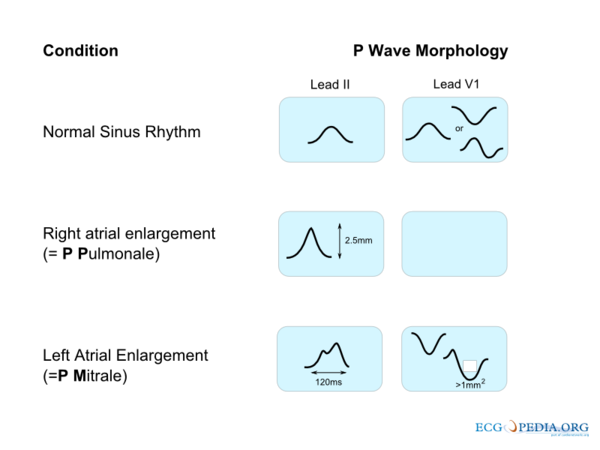P Wave Morphology: Difference between revisions
Jump to navigation
Jump to search
No edit summary |
|||
| Line 5: | Line 5: | ||
|nextname=Step 6: QRS morphology | |nextname=Step 6: QRS morphology | ||
}} | }} | ||
{|style="float:right" | |||
| | |||
{{authors| | {{authors| | ||
|mainauthor= [[user:Drj|J.S.S.G. de Jong, MD]], A. Bouhiouf, Msc | |mainauthor= [[user:Drj|J.S.S.G. de Jong, MD]], A. Bouhiouf, Msc | ||
| Line 15: | Line 17: | ||
[[Image:p_wave_morphology.png|thumb|Altered P wave morfology is seen in left or right atrial enlargement.]] | [[Image:p_wave_morphology.png|thumb|Altered P wave morfology is seen in left or right atrial enlargement.]] | ||
[[Image:pta_changes.svg|thumb|The PTa segment can be used to diagnose pericarditis or atrial infarction.]] | [[Image:pta_changes.svg|thumb|The PTa segment can be used to diagnose pericarditis or atrial infarction.]] | ||
|} | |||
The '''P wave morphology''' can reveal right or left atrial stretch or atrial arrhythmias and is best determined in leads II and V1 during sinus rhythm. | The '''P wave morphology''' can reveal right or left atrial stretch or atrial arrhythmias and is best determined in leads II and V1 during sinus rhythm. | ||
| Line 38: | Line 40: | ||
Image:Nsr.jpg|Another example of normal sinus rhythm. | Image:Nsr.jpg|Another example of normal sinus rhythm. | ||
</gallery> | </gallery> | ||
{{clr}} | |||
{{box| | |||
==References== | ==References== | ||
<biblio> | <biblio> | ||
#Spodick pmid=1575201 | #Spodick pmid=1575201 | ||
</biblio> | </biblio> | ||
}} | |||
[[Category:ECG Course]] | |||
Revision as of 17:01, 30 May 2009
| «Step 4:Heart axis | Step 6: QRS morphology» |
   | |||||||||
The P wave morphology can reveal right or left atrial stretch or atrial arrhythmias and is best determined in leads II and V1 during sinus rhythm.
| Characteristics of a normal p wave:Spodick |
|---|
|
Elevation or depression of the PTa segment (the part between the p wave and the beginning of the QRS complex) can result from Atrial infarction or pericarditis.
If the p-wave is enlarged, the atria are enlarged.
If the P wave is inverted, it is most likely an ectopic atrial rhythm not originating from the sinus node.
Examples
-
An example of normal sinus rhythm.
-
Another example of normal sinus rhythm.
{{{1}}}

